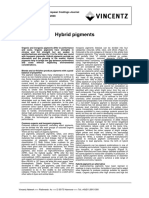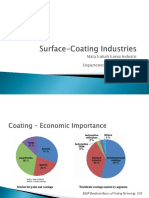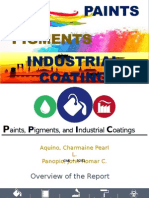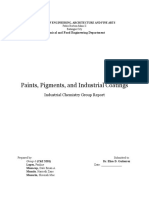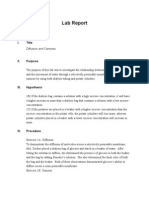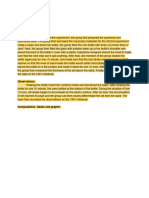Nexant - Organic Pigments Landscape - Blog 09-May-2019
Nexant - Organic Pigments Landscape - Blog 09-May-2019
Uploaded by
parthchillCopyright:
Available Formats
Nexant - Organic Pigments Landscape - Blog 09-May-2019
Nexant - Organic Pigments Landscape - Blog 09-May-2019
Uploaded by
parthchillOriginal Description:
Copyright
Available Formats
Share this document
Did you find this document useful?
Is this content inappropriate?
Copyright:
Available Formats
Nexant - Organic Pigments Landscape - Blog 09-May-2019
Nexant - Organic Pigments Landscape - Blog 09-May-2019
Uploaded by
parthchillCopyright:
Available Formats
The organic pigments landscape:
challenges for producers like Clariant and BASF
The pigments industry is seeing another brush of restructuring – Clariant and BASF
have both announced that they are divesting their pigments businesses this year.
When thinking about the best strategic course for a buyer of either business, a look at
the challenges posed from the wider industry landscape is critical. Key questions are
whether EBITDA margins are sustainable and how much can they be improved?
Pigments are defined as colouring agents that are practically insoluble in the application
PIGMENTS
medium, whereas dyes are colouring agents that are soluble in the application medium.
Inorganic pigments are chemical compounds not based on carbon and are usually metallic
salts precipitated from solutions or calcined at high temperatures.
Organic pigments are derived from synthetic carbon chemistry. However, they can also contain
metallic (inorganic) elements that help stabilize the properties of the organic components.
The different pigment types vary in market applications reflecting their cost and performance
properties – this has implications on growth rates.
Overall the organic pigment industry consists of a handful of large multi-national companies
(e.g. Clariant and BASF) with revenues >$1 billion and which offer a wide portfolio of colours
for various applications. The next tier of producers comprises the medium sized players (of
around $100-$500 million in revenue) e.g. Heubach in Germany, Union Colours, Lily Group
in China and Sudarshan in India. The medium-sized Asian players typically have “me-too
offerings” in their portfolio to compete with the market leaders. Then there are small
companies with revenues typically < $10 million which are focused on specific pigment
chemistries.
The organic pigments landscape April 2019 1
Pigments value chain Paint and ink
Liquid colorants
manufacturers
(e.g. Chromaflo)
(e.g. AkzoNobel)
Pigments
Chemical Dispersions
production
intermediates (e.g. Clariant)
(e.g. Clariant)
Masterbatch Plastic converters
(e.g. Clariant) (e.g. LyondellBasell)
Dry Powder
(e.g. Clariant)
Paint and ink
manufacturers
(e.g. AkzoNobel)
Pigments are largely sold as dry powder (e.g., approximately 70% of Clariant sales
volumes) – these pigments are then formulated as dispersions with other additives
Coatings (in the form of paints and inks) are the largest market for colour pigments,
representing more than half of demand.
Other applications depend on the type of pigment but include higher volume concrete,
ceramics and other building materials, plastics as well as lower volume but higher value
cosmetics and other high-purity applications.
Global pigments producers also develop their own formulations (masterbatches and
liquid colourants etc.) to market directly to coatings producers and polymer
converters
Dispersions are semi-prepared products that provide system and / or logistics efficiencies
in the supply chain.
Growth of pigments is driven by its use in printing inks, paints and plastics
Pigment type Main applications Global
demand
Architectural Industrial Automotive outlook
Plastics Inks Other
paints coatings coatings (vs. GDP)
INORGANICS
TiO2 Personal care
Carbon black Rubber tyres
Iron oxides Cosmetics
Concrete
Zinc oxides Personal care
Ultramarine Cosmetics
Mixed metal oxides Ceramics
ORGANIC
Azo pigments
Polycyclic pigments
SPECIAL EFFECT PIGMENTS
Effect pigments Cosmetics
(pearlescent etc.)
Functional pigments Electronics
(e.g. anti-corrosion)
The organic pigments landscape April 2019 2
Clariant is mostly focused on organic and specialty pigments and has recently
carved-out this division into a separate entity. The business is mainly oriented to
organic pigments with a relatively strong position in the architectural coatings
segment. BASF has a large portfolio of organic and specialty pigments, with
particular strength in automotive coatings. Coatings (in the form of paints and inks)
are the largest market for colour pigments, representing more than half of demand.
Clariant and BASF are each quite different pigments companies – based on pigment
portfolio and end-market focus. Both are global, leading and well-established pigment
producers and are focused on organic pigments and dispersions for all major end-markets
e.g. inks, coatings and polymers. However the BASF portfolio also brings with it a palate of
complex inorganic coloured pigments (CCIPS) and pearlescent pigments(1) which were
acquired from its Engelhard acquisition back in 2006. From its acquisition of Ciba in 2009,
BASF also acquired a larger portfolio of organic pigments. The end-market focus of both
businesses also varies due to inter-company relationships. Clariant Pigments has a strong
offering in polymers due its masterbatch business while BASF is more focused on coatings
(particularly automotive coatings) where it is also active.
(1)
Pearlescent pigments are semi-transparent and allow some light to pass through their surface and absorb and scatter light as
well. The main applications are paints, inks, plastics and cosmetics.
Pigments market structure
Selected producers Pigments produced
Inorganics Organics Specialities
Clariant
BASF
DIC (incl. Sun Chemical)
Heubach
Ferro
Venator (ex Huntsman)
Lanxess
Altana (Eckart)
Sudarshan (India)
Meghmani Organics (India)
Changzhou North American Chemical Group (China)
Lily Group (Hangzhou Baihe Chemical) (China)
Strategic partnerships and raw material sourcing will be top of the agenda
In the 1990s the organic pigments industry in Western countries was facing compliance with
environmental regulations and uncertainty in raw material availability. Almost three decades
later, these themes are being replayed in Asia. Since 2017, the entire industry has been
feeling the pinch from raw material disruptions caused by the enforcement of environmental
regulations in China (known as “Blue Sky” initiatives). Aromatics (benzene, toluene, xylenes)
and naphthalene derivatives are the main building blocks of organic pigments; these
feedstocks are widely produced in Asia due to the cracking of heavier feedstock for ethylene
production and also the availability of coal tar (a by-product of coke ovens from steel and
aluminium smelting).
Several producers have seen a shortage of specific pigments such as pigment yellow 74 due
to lack of raw materials. With softening demand in some end-markets e.g. automotive, some
producers have struggled to pass through the full cost increases to customers. The impact
of such supply chain disruption is not yet over and may later repeat itself in adjacent markets
such as India.
The organic pigments landscape April 2019 3
Illustrative process for pigment yellow 74 production
Steam
NaOH
Sodium acetate Water
2-methoxy-4-nitroaniline
HCI (31 wt%) Diazo solution
Water and ice preparation
Sodium nitrate (40%)
Coupling Pigment
Filtration Drying Pulverisation
reaction Yellow 74
Acetoacet-2-anisidide Coupling
Water and ice solution
Caustic preparation
Waste Recovered
Water solvent
The perceived commoditisation of the pigments industry and increased competition is
also a challenge for all players
It is widely known that the influx of Chinese and Indian producers increased the competitive
pressure for pigment producers. Certain pigments such as phthalocyanine blues and greens
are intensely competitive – so much so that India producers now dominate this segment of
the market. Western players in turn have invested in their own capacity or in JV production
capacity in China and India to gain a competitive feedstock position and to be closer to
customers. Western producers have also optimised their production assets by having
production of some pigments in China or India while keeping production of high performance
pigments and dispersions in the West.
Another differentiation strategy by some players is to focus on higher value-added segments
within end-markets. Over half of organic pigments by volume is used in inks – from a broad
view, this is a more commoditised and low growth area for pigment suppliers followed by
polymers and then coatings (less commoditised). However, look beneath the layers and
there are still some more attractive areas which tend to attract higher margins e.g. inks for
food applications where additional processing is required to reduce the primary aromatic
amine content (PAA) or digital inks where technical specifications, such as narrow particle
size distribution are critical.
In this now muddled pigments landscape, there is still specialisation required and services
valued by customers which differentiate producers. Suppliers must meet customer testing
requirements to ensure the technical performance and reproducibility of each batch of
pigment. In certain end-markets such as automotive, pigments must have leading
performance e.g. high light fastness and heat stability. Other technical defining properties
include tinting strength, dispersibility and opacity.
In the dispersions/colourant sub-segment (one step down the pigments value chain), there is
less perceived commoditisation. Dispersions allow for optimal properties of the pigment to
be achieved and create ease of use for the customer. Upcoming Asian players are looking
to gain additional footing here as they grow and challenge the incumbent leading producers
such as Clariant and BASF. There are also several strong players solely in the colourants
market which may facilitate further growth opportunities for pigment producers.
There is growing interest in the market for more sustainable pigment solutions – this
could be a further area of differentiation among players
Clariant leads the market as the first pigment producer to offer some HPP (high performance
pigments) quinacridone pigments based on renewable bio-succinic acid. The bio-succinic
acid feedstock is sourced from Myriant for use in Clariant’s Frankfurt-Hoechst facility. It is
also the only producer to offer a bio-based version of DPP (diketopyrrolopyrrole) pigment
red 254 (launched in March 2019).
The organic pigments landscape April 2019 4
The strongest players will thus sustain their margins by having a strong supply chain,
customer service focus plus a tailored and sustainable product portfolio. Clariant has
taken several actions along these lines to adapt to changes in market demand and
emerging competition
Clariant Pigments (indicative financial performance)
3000 22
20
2500 3
1 18
2
16
2000
14
4
Million CHF
EBITDA, %
12
1500
10
8
1000
6
500 4
2
0 0
1996 1997 1998 1999 2000 2001 2002 2003 2004 2005 2006 2007 2008 2009 2010 2011 2012 2013 2014 2015 2016 2017 2018
Pigments & Additives EBITDA Pigments & Additives
Plastics & Coatings EBITDA Plastics & Coatings
Pigments EBITDA Pigments
Selected highlights:
1 2001-2002: Volume and price pressure (from Asian players); launch of 4 HPPs
2 2006: Portfolio reduction of bulks by 10% vs plan of 30%
2007: Rising oil prices -$72.5/bbl average; new cost leadership strategy for the Pigments & Additives
division – including customer base rationalization, site closures (Germany and US) and introduction of Six
Sigma; agreement with Zhejiang Bahie Chemical Holding Group to expand production of high-
performance quinacridone pigments
2008: Overhead costs declined by 30% from Lean Six Sigma program; further rationalisation (Coventry,
US and Horsforth, U.K)
2009: Global financial crisis, weak demand
3 As of Jan 1, 2010, the Group organized into 10 Business Units – one of which was Pigments
2010: Further facility closures (Muttenz, Switzerland, Thane, India and Onsan, Korea); cost efficiency
supports margins
2011-2013: Brent crude averages $100/bbl; acquisition of Italtinto (colour mixing systems)
2012: weak European demand and lower capacity utilization
4 From 1 Jan 2013, Clariant regrouped the 7 BUs into 4 Business Areas. Plastics & Coatings includes BU
Additives, BU Masterbatches and BU Pigments
2014: Clariant announces use of bio-based feedstocks for quinacridone pigments at Frankfurt
2018: Project Clockwork to improve effectiveness and efficiency of the end-to-end supply chain
2019: Clariant launches bio-based version of Pigment Red 254
Sustaining EBITDA margins in the range of 15 percent appears to be achievable for a
new owner of the Clariant Pigments business
Jonathan Bourne Kami Tang Pack (Author)
Vice-President, Energy & Chemicals Advisory Senior Consultant, Energy & Chemicals Advisory
jbourne@nexant.com ktangpack@nexant.com
+44 20 7950 1597 +44 20 7950 1543
The organic pigments landscape April 2019 5
You might also like
- Masterbatch Market 2016Document229 pagesMasterbatch Market 2016Manuel González ValleNo ratings yet
- Producerea RasinilorDocument115 pagesProducerea RasinilorPaul Chende100% (2)
- Hybrid Pigments: Quelle/Publication: European Coatings Journal Ausgabe/Issue: 06/2008 Seite/PageDocument10 pagesHybrid Pigments: Quelle/Publication: European Coatings Journal Ausgabe/Issue: 06/2008 Seite/PageKalpesh PatelNo ratings yet
- Manufacturing of Acrylic Acid PDFDocument18 pagesManufacturing of Acrylic Acid PDFSuvin MadhuNo ratings yet
- Module 9a Buffer Preparation and Hydrolysis of Salts ConceptDocument10 pagesModule 9a Buffer Preparation and Hydrolysis of Salts ConceptYuan MasudaNo ratings yet
- The World of Inorganic PigmentsDocument17 pagesThe World of Inorganic PigmentsProf. Jaqueline FerroNo ratings yet
- Important Paint Manufacturing ProcessesDocument27 pagesImportant Paint Manufacturing Processesapi-2752658788% (68)
- PigmentsDocument6 pagesPigmentsrashed141_tx100% (1)
- Organic Pigments For Coatings Aug '21Document20 pagesOrganic Pigments For Coatings Aug '21Borja AzkargortaNo ratings yet
- PFD FileDocument44 pagesPFD FilerahulkhakhriyaNo ratings yet
- Bolger Ohearn ProductsDocument4 pagesBolger Ohearn ProductsUtpalNo ratings yet
- Aniline Kiri IndustriesDocument3 pagesAniline Kiri Industriessumit6singhNo ratings yet
- Use of Nanomaterials in Coatings 0 PDFDocument18 pagesUse of Nanomaterials in Coatings 0 PDFCong ChinhNo ratings yet
- Products For Non Impact PrintingDocument36 pagesProducts For Non Impact PrintingRomán M Martín del CNo ratings yet
- Surface-Coating Industries (2022)Document48 pagesSurface-Coating Industries (2022)sandraNo ratings yet
- Paints, Pigments, and Industrial CoatingsDocument59 pagesPaints, Pigments, and Industrial CoatingsRomar Panopio100% (4)
- Surface CoatingDocument29 pagesSurface CoatingAbdullah RamzanNo ratings yet
- 3 C Report of Berger PaintDocument8 pages3 C Report of Berger PaintSanjeetNo ratings yet
- Catalogue Pigments For Printing Inks PDFDocument20 pagesCatalogue Pigments For Printing Inks PDFFitria PuspitaNo ratings yet
- Indian Decorative Paint IndustryDocument26 pagesIndian Decorative Paint IndustryChandrakant Halli100% (1)
- Aplikasi Surfaktan Di IndustriDocument27 pagesAplikasi Surfaktan Di IndustriDzaki AssuhudNo ratings yet
- Paint Industry Analysis: Presented By, Rarichan MathewDocument21 pagesPaint Industry Analysis: Presented By, Rarichan MathewAlexNo ratings yet
- The Dyestuff Industry EditDocument7 pagesThe Dyestuff Industry EditNumair ToleNo ratings yet
- Global Organic Pigments Market 2017 To 2023Document5 pagesGlobal Organic Pigments Market 2017 To 2023Industry Experts, Inc.No ratings yet
- Chemicals For Substitution of Hazardous ChemicalsDocument6 pagesChemicals For Substitution of Hazardous ChemicalsFatima AnwarNo ratings yet
- Paints and Pigments ReportDocument7 pagesPaints and Pigments Reportnica roseNo ratings yet
- HM Chemical Restrictions Part 3Document21 pagesHM Chemical Restrictions Part 3THYAGUNo ratings yet
- For BeeDocument13 pagesFor Beebhanu sharmaNo ratings yet
- For BeeDocument15 pagesFor Beebhanu sharmaNo ratings yet
- Arkema Global Coatings Offer 2014Document12 pagesArkema Global Coatings Offer 2014Ahmed TahaNo ratings yet
- Textile PigmentsDocument3 pagesTextile PigmentsTariqul IslamNo ratings yet
- Creating A New Paint Company Branding Product ManagementDocument89 pagesCreating A New Paint Company Branding Product ManagementjohnNo ratings yet
- An in Plant Training Report: Basf India LTDDocument43 pagesAn in Plant Training Report: Basf India LTDKrishna YeoleNo ratings yet
- Fire Mechanisms and Phosphate EstersDocument40 pagesFire Mechanisms and Phosphate EstersahmetNo ratings yet
- Industrial, Air, Water Pollution: Vaughnette Erika B. Salimbagat Keziah Rose B. SalvadorDocument95 pagesIndustrial, Air, Water Pollution: Vaughnette Erika B. Salimbagat Keziah Rose B. SalvadorRustom IbanezNo ratings yet
- Market Scenario - Stakeholders - Painting System: - Conventional Practice - Gyproc SystemDocument11 pagesMarket Scenario - Stakeholders - Painting System: - Conventional Practice - Gyproc SystemPriyaNo ratings yet
- Brand Revitalization of Pailac Paints 160805153026Document23 pagesBrand Revitalization of Pailac Paints 160805153026Arif Khan NabilNo ratings yet
- Overview of The Chemical IndustryDocument10 pagesOverview of The Chemical Industryakshriv4uNo ratings yet
- Equivalencias ClariantDocument72 pagesEquivalencias ClariantKaren Ivet García TéllezNo ratings yet
- MgCO3 Naikai Japan - Brocure & TDSDocument1 pageMgCO3 Naikai Japan - Brocure & TDSAreIf Cron BmxStreetNo ratings yet
- Green Assure - VOC Standard Compliance by Asian PaintsDocument2 pagesGreen Assure - VOC Standard Compliance by Asian PaintspallabdgNo ratings yet
- Typical Adverse Location EnvironmentsDocument1 pageTypical Adverse Location EnvironmentsKarlos Antonio Salinas MoralesNo ratings yet
- Department of Chemistry: Name - Soumya Ray Course - M.SC Semester - 3Document15 pagesDepartment of Chemistry: Name - Soumya Ray Course - M.SC Semester - 3Soumya RayNo ratings yet
- Generic Latex Paint ProductsDocument6 pagesGeneric Latex Paint ProductsFercho LotudoNo ratings yet
- Avalon Perspectives - Specialty ChemicalsDocument44 pagesAvalon Perspectives - Specialty Chemicalslps.iitmNo ratings yet
- Product Offer de CON enDocument14 pagesProduct Offer de CON enForeverNo ratings yet
- ECKART-Metal and Effect PigmentDocument80 pagesECKART-Metal and Effect PigmentXuân Giang NguyễnNo ratings yet
- Paints and VarnishesDocument24 pagesPaints and VarnishesEmina HuseinovicNo ratings yet
- NSE Indices - Industry Classification Structure-2022-04Document29 pagesNSE Indices - Industry Classification Structure-2022-04Joydeep HazraNo ratings yet
- Bayferrox Iron Oxide PigmentDocument9 pagesBayferrox Iron Oxide PigmentMuzammal HussainNo ratings yet
- Ec Dossier Pigments PDFDocument95 pagesEc Dossier Pigments PDFEmilio HipolaNo ratings yet
- 0260.SAS-BR-IW Chemistry WEB 0 PDFDocument8 pages0260.SAS-BR-IW Chemistry WEB 0 PDFTasos ChristouNo ratings yet
- Final ReportDocument67 pagesFinal Reportpmcmbharat264No ratings yet
- Paints and LacquersDocument16 pagesPaints and LacquersM IdreesNo ratings yet
- Nse Indices Industry Classification Structure 2023 07Document20 pagesNse Indices Industry Classification Structure 2023 07Subhash SamotaNo ratings yet
- The Chemistry of Pigments and its Classifications: Education&Science, #2From EverandThe Chemistry of Pigments and its Classifications: Education&Science, #2No ratings yet
- Water-based Acrylic Dispersions: Applications in Architectural CoatingsFrom EverandWater-based Acrylic Dispersions: Applications in Architectural CoatingsNo ratings yet
- Analisys and application of dry cleaning materials on unvarnished pain surfacesFrom EverandAnalisys and application of dry cleaning materials on unvarnished pain surfacesNo ratings yet
- Ec tech report architectural and decorative coatings: Water-based and sustainableFrom EverandEc tech report architectural and decorative coatings: Water-based and sustainableVincentz Network GmbH & Co KGNo ratings yet
- Industrial Organic Pigments: Production, Properties, ApplicationsFrom EverandIndustrial Organic Pigments: Production, Properties, ApplicationsNo ratings yet
- Rethinking Acrylic: Radical Solutions For Exploiting The World's Most Versatile MediumFrom EverandRethinking Acrylic: Radical Solutions For Exploiting The World's Most Versatile MediumRating: 4.5 out of 5 stars4.5/5 (3)
- Asia Chemicals Outlook Final Version SmallDocument105 pagesAsia Chemicals Outlook Final Version SmallparthchillNo ratings yet
- Galaxy Surfactants Limited: Niranjan Arun KetkarDocument41 pagesGalaxy Surfactants Limited: Niranjan Arun KetkarparthchillNo ratings yet
- IOI Corporation Berhad Circular To Shareholders 2021Document32 pagesIOI Corporation Berhad Circular To Shareholders 2021parthchillNo ratings yet
- CEMP Appendix R2: Environmental Concentrations of Radionuclides Associated With The Offshore Oil and Gas Non Nuclear Sector (Revised 2017)Document2 pagesCEMP Appendix R2: Environmental Concentrations of Radionuclides Associated With The Offshore Oil and Gas Non Nuclear Sector (Revised 2017)parthchillNo ratings yet
- Hilti Sustainability Report - 2020 - enDocument88 pagesHilti Sustainability Report - 2020 - enparthchillNo ratings yet
- Microsoft BCG Focus MSFT IoTDocument24 pagesMicrosoft BCG Focus MSFT IoTparthchillNo ratings yet
- Shell EuropaDocument2 pagesShell EuropaparthchillNo ratings yet
- General - CH12 - Cleaning & CorrosionDocument73 pagesGeneral - CH12 - Cleaning & Corrosionali amrNo ratings yet
- Pro Brite IIDocument2 pagesPro Brite IIazambhabibNo ratings yet
- 1.the Aim of ExerciseDocument3 pages1.the Aim of ExerciseKarolina DróżdżNo ratings yet
- The Rapid Detection of Antioxidants From SafflowerDocument7 pagesThe Rapid Detection of Antioxidants From SafflowerRaquel Manzano DuránNo ratings yet
- Lab Report: I. TitleDocument13 pagesLab Report: I. TitleCatherine Marie Tucker100% (2)
- Manual SupelcoDocument12 pagesManual Supelcogrubensam100% (3)
- Fariz Arif Khan - Periodic TableDocument4 pagesFariz Arif Khan - Periodic TableFariz Arif KhanNo ratings yet
- Drone SurveyDocument4 pagesDrone Survey丨ㄒ丂ᐯ乇ᗪ卂几ㄒNo ratings yet
- Beee-Part A&bDocument254 pagesBeee-Part A&babdulrehamanshaik452No ratings yet
- To Additional PrintDocument6 pagesTo Additional PrintJAN JERICHO MENTOYNo ratings yet
- Chemistry Project On Saturated Solutions: Measuring SolublityDocument15 pagesChemistry Project On Saturated Solutions: Measuring SolublityDhiraj AgarwalaNo ratings yet
- WEEK-6-Q2-GEN CHEM-Dec 4-8-DLLDocument6 pagesWEEK-6-Q2-GEN CHEM-Dec 4-8-DLLJennette BelliotNo ratings yet
- Dyna PoreDocument12 pagesDyna PoreW Morales100% (1)
- CH - 2 - Measurement of Length, Volume, Time and Mass PDFDocument6 pagesCH - 2 - Measurement of Length, Volume, Time and Mass PDFNcnagesh PrasadNo ratings yet
- 14 - OscillationsDocument18 pages14 - Oscillationstranquil_452889939No ratings yet
- Advanced Ceramics - 4th Year - Lecture NotesDocument44 pagesAdvanced Ceramics - 4th Year - Lecture Notesdrsaadbhf100% (1)
- Role & Rationale of Gandhaka ShodhanaDocument60 pagesRole & Rationale of Gandhaka ShodhanaPraveen Rao100% (1)
- Silt Test Materials: Objectives: ProceduresDocument20 pagesSilt Test Materials: Objectives: ProceduresPeetah MorrisNo ratings yet
- MolesDocument7 pagesMolesNyonikaNo ratings yet
- Roland Winston: Science of Nonimaging Optics: The Thermodynamic ConnectionDocument100 pagesRoland Winston: Science of Nonimaging Optics: The Thermodynamic ConnectionGörkem VarolNo ratings yet
- RadioactivityDocument11 pagesRadioactivityKailey TateNo ratings yet
- Dynamics Lecture No 15 BDocument9 pagesDynamics Lecture No 15 BLeo KhanNo ratings yet
- Current Electricty 01 Board QuestionsDocument2 pagesCurrent Electricty 01 Board QuestionsDivyanshi KhareNo ratings yet
- Ox0 Alcohols: Report No. 21Document9 pagesOx0 Alcohols: Report No. 21kaimanwatsoNNo ratings yet
- Chapter 1 - 9th Science Subjects Tests - Nauman SadafDocument22 pagesChapter 1 - 9th Science Subjects Tests - Nauman SadafMohammad AshfaqNo ratings yet
- Electric and Magnetic FieldsDocument2 pagesElectric and Magnetic FieldsShootingStarPhotonsNo ratings yet
- Mapua Institute of Technology: Experiment No. 2Document14 pagesMapua Institute of Technology: Experiment No. 2Mark PulongbaritNo ratings yet
- BITUMENDocument35 pagesBITUMENIZIMBA0% (1)


